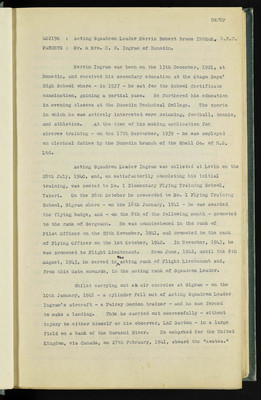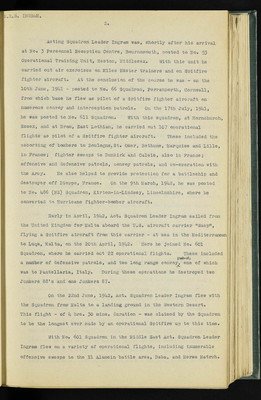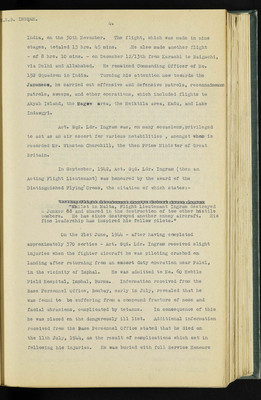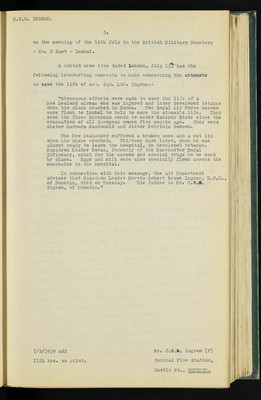Pages
11
HW/NF (right aligned) 402190 : Acting Squadron Leader Mervin Robert Bruce INGRAM. D.F.C. PARENTS : Mr. & Mrs. C.W. Ingram of Dunedin.
Mervin Ingram was born on the 13th December, 1921, at Dunedin, and received his secondary education at the Otago Boys' High School where - in 1937 - he sat for the School Certificate examination, gaining a partial pass. He furthered his education in evening classes at the Dunedin Technical College. The sports in which he was actively interested were swimming, football, tennis, and athletics. At the time of his making application for aircrew training - on the 17th September, 1939 - he was employed on clerical duties by the Dunedin branch of the Shell Co. of N.Z. Ltd.
Acting Squadron Leader Ingram was enlisted at Levin on the 28th July, 1940, and, on satisfactorily completing his initial training, was posted to No. 1 Elementary Flying Training School, Taieri. On the 26th October he proceeded to No. 1 Flying Training School, Wigram where - on the 16th January, 1941 - he was awarded the flying badge, and - on the 8th of the following month - promoted to the rank of Sergeant. He was commissioned in the rank of Pilot Officer on the 29th November, 1941, and promoted to the rank of Flying Officer on the 1st October, 1942. In November, 1943, he was promoted to Flight Lieutenant. From June, 1942, until the 8th August, 1943, he served in the acting rank of Flight Lieutenant and, from this date onwards, in the acting rank of Squadron Leader.
Whilst carrying out an air exercise at Wigram - on the 10th January, 1941 - a cylinder fell out of Acting Squadron Leader Ingram's aircraft - a Fairey Gordon trainer - and he was forced to make a landing. This he carried out successfully - without injury to either himself or his observer, LAC Barton - in a large field on a bank of the Hurunui River. He embarked for the United Kingdom, via Canada, on 27th February, 1941, aboard the "Awatea."
12
M.R.B. INGRAM. 2. (centre aligned) Acting Squadron Leader Ingram, was shortly after his arrival at No. 3 Personnel Reception Centre, Bournemouth, posted to No. 53 Operational Training Unit, Heston, Middlesex. With this unit he carried out air exercises on Miles Master trainers and on Spitfire fighter aircraft. At the conclusion of the course he was - on the 10th June, 1941 - posted to No. 66 Squadron, Perranport, Cornwall, from which base he flew as pilot of a Spitfire fighter aircraft on numerous convoy and interception patrols. On the 17th July, 1941, he was posted to No. 611 Squadron. With this squadron, at Hornchurch, Essex, and at Drem, East Lothian, he carried out 107 operational flights as pilot of a Spitfire fighter aircraft. These included the escorting of bombers to Boulogne, St. Omer, Bethune, Marquise and Lille, in France; fighter sweeps to Dunkirk and Calais, also in France; offensive and defensive patrols, convoy patrols, and co-operation with the Army. He also helped to provide protection for a battleship and destroyer off Dieppe, France. On the 9th March, 1942, he was posted to No. 486 (NZ) Squadron, Kirton-in-Lindsey, Lincolnshire, where he converted to Hurricane fighter-bomber aircraft.
Early in April, 1942, Act. Squadron Leader Ingram sailed from the United Kingdom for Malta aboard the U.S. aircraft carrier "Wasp", flying Spitfire aircraft from this carrier - at sea in the Mediterranean to Luqa, Malta, on the 20th April, 1942. Here he joined No. 601 Squadron, where he carried out 22 operational flights. These included a number of defensive patrols, and two long range convoy patrols, one of which was to Pantellaria, Italy. During these operations he destroyed two Junkers 88's and one Junkers 87.
On the 22nd June, 1942, Act. Squadron Leader Ingram flew with the Squadron from Malta to a landing ground in the Western Desert. This flight - of 4 hrs. 30 mins. duration - was claimed by the Squadron to be the longest ever made by an operational Spitfire up to this time.
With No. 601 Squadron in the Middle East Act. Squadron Leader Ingram flew on a variety of operational flights, including inumerable offensive sweeps to the El Alamein battle area, Daba, and Mersa Matruh.
13
M.R.B. INGRAM. 3. (centre aligned)
He destroyed five enemy aircraft, partly destroyed three others, probably destroyed three, and damaged three. On the afternoon of the 9th August, 1942, his aircraft crash landed on his base aerodrome and drifted off the runway into the sand and overturned. He received multiple abrasions and was admitted to the RAF Hospital, Egypt, where he remained until the end of the month. During the period 30th December, 1942 - 21st June, 1943 he was stationed at No. 1 Middle East Training School, Ballah, and at No. 73 Operational Training Unit, Abu Sueir, and with these units carried out instructional duties on Harvard trainers, and Kittyhawk and Spitfire fighter aircraft. He was also at No. 244 Wing Base Training Pool for approximately one month awaiting posting to a unit. On the 1st April, 1943, whilst at No. 73 OTU he took part in a display to celebrate the 25th Anniversary of the Royal Air Force.
In June, 1943, Act. Sqd. Ldr. Ingram returned to Malta and was stationed with No. 232 Squadron at Takali and Halfar until the Squadron moved to Sicily after the invasion of the island early in July, 1943. During his operations with the squadron - whilst providing fighter cover for roads in the Etna area, Sicily - he attacked and damaged an additional enemy aircraft. On the 8th August, 1943, he was posted to No. 152 (Hyderabad) Squadron, Sicily, as Commanding Officer, and during the period of 10th August - 3rd November carried out a further 45 operational flights. These included many patrols in the Straits of Messina area, and the escortin of Kittyhawk fighter aircraft on anti-shipping strikes at Messina and Bagra, Italy. He also carried out sweeps and beach patrols on and about the landing at Salerno, Italy - early in September, 1943. Flying a Spitfire fighter aircraft during these operations, he scored 1½ enemy aircraft destroyed and 1 damaged.
In November, 1943, Act. Sqd. Ldr. Ingram returned to the Middle East en route to India. Flying as pilot of a Spitfire aircraft he took off from Helwan, Egypt on 26th November, and leading the Squadron, proceeded via Bahrein Island, in the Persian Gulf, and Shanja, Arabia, arriving at Mau Ranipur, United Provinces,
14
M.R.B. INGRAM. 4. (centre aligned)
India, on the 30th November. The flight, which was made in nine stages, totaled 13 hrs. 45 mins. He also made another flight - of 8 hrs. 10 mins. - on December 12/13th from Karachi to Baigac via Delhi and Allahabad. He remained Commanding Officer of No. 152 Squadron in India. Turning his attention now towards the Japanese, he carried out offensive and defensive patrols, reconnaissance patrols, sweeps, and other operations, which included flights to Akyab Island, the Magwe area, the Meiktila area, Kadu, and Lake Indawgyi.
Act. Sqd. Ldr. Ingram was, on many occasions, privileged to act as an air escort for various notabilities, amongst whom I recorded Mr. Winston Churchill, the then Prime Minister of Great Britian.
In September, 1942, Act. Sqd. Ldr. Ingram (then an Acting Flight Lieutenant) was honoured by the award of the Distinguished Flying Cross, the citation of which states:- (indented) Whilst in Malta, Flight Lieutenant Ingram destroyed a Junker '88 and shared in the destruction of two other hostile bombers. He has since destroyed other enemy aircraft. His fine leadership has inspired his fellow pilots."
On the 21st June, 1944 - after having completed approximately 370 sorties - Act. Sqd. Ldr. Ingram received slight injuries when the fighter aircraft he was piloting crashed on landing after returning from and escort duty operation near Palel, in the vicinity of Imphal. He was admitted to No. 60 Mobile Field Hospital, Imphal, Burma. Information received from the Base Personnel Office, Bombay, early in July, revealed that he was found to be suffering from a compound fracture of nose and facial abrasions, complicated by tetanus. In consequence of this he was placed on the dangerously ill list. Additional information received from the Base Personnel Office stated that he died on the 11th July, 1944, as the result of complications which set in following his injuries. He was buried with full Service Honours
15
M.R.B. INGRAM. 5. (centre aligned)
on the morning of the 12th July in the British Military Cemetery - No. 2 East - Imphal.
A cabled news item dated London, July 13th, has the following interesting comments to make concerning the attempts to save the life of Act. Sqd. Ldr. Ingram:-
(indented) "Strenouous efforts were made to save the life of a New Zealand airman who was injured and later developed tetanus when his plane crashed in Burma. Two Royal Air Force nurses were flown to Imphal to help to save the airman's life. They were the first European women to enter Manipur State since the evacuation of all European women five months ago. They were Sister Barbara MacDonald and Sister Patricia Dawson.
The New Zealander suffered a broken nose and a cut lip when his plane crashed. Thirteen days later, when he was almost ready to leave the hospital, he developed tetanus. Squadron Leader Doran, formerly of the Manchester Royal Infirmary, asked for the nurses and special drugs to be sent by plane. Eggs and milk were also specially flown across the mountains to the hospital.
In connection with this message, the Air Department advises that Squadron Leader Mervin Robert Bruce Ingram, D.F.C. of Dunedin, died on Tuesday. His father is Mr. C.W.N. Ingram of Dunedin."
5/2/3939 AS2 1124 hrs. as pilot.
Mr. C.W.N. Ingram (F) (right aligned) Central Fire Station, (right aligned) Castle St., DUNEDIN (right aligned & town underlined)




